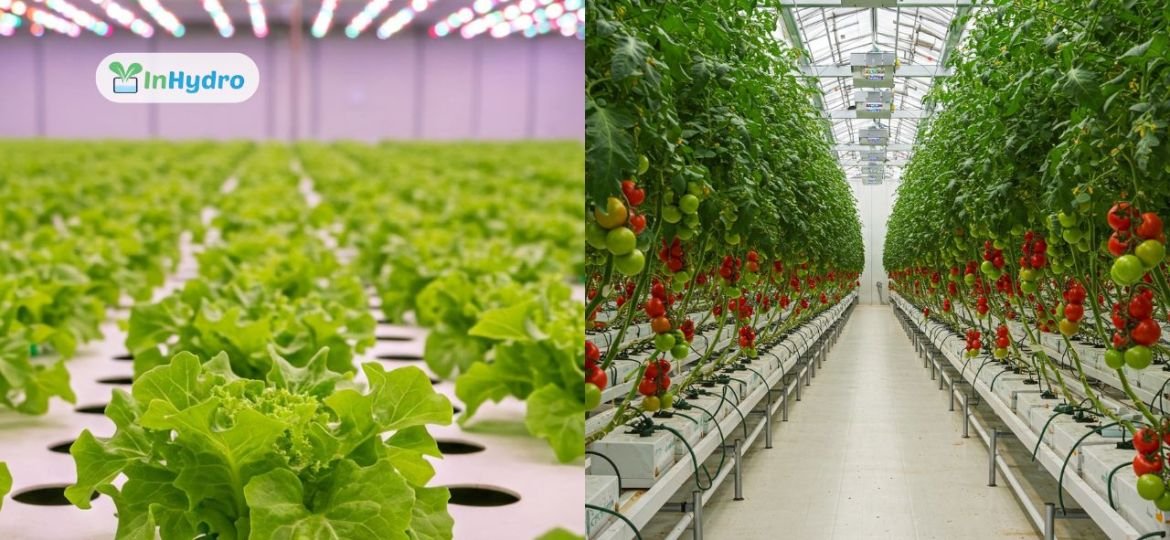
Growing Leafy Greens vs. Fruiting Plants: Choosing the Right Hydroponic System
Hydroponics has revolutionized the way we grow food. From urban rooftops to climate-controlled greenhouses, farmers today are making data-driven decisions to grow better, faster, and cleaner. But one of the most important choices a grower makes early on is what to grow. And that decision—between leafy greens and fruiting plants—directly impacts the hydroponic system best suited for the job.
At InHydro, we often guide first-time hydroponic growers through this crossroads. The crops you choose dictate not just the structure and scale of your farm but also nutrient management, support systems, harvesting cycles, and overall returns. Let’s explore how leafy greens differ from fruiting crops, and what that means for system selection.
Understanding the Nature of the Crop
Leafy greens such as lettuce, kale, spinach, and herbs are relatively light, shallow-rooted, and quick to mature. They are perfect for fast harvest cycles and quick market turnaround. These plants typically mature within 3 to 5 weeks, consume fewer nutrients, and thrive in cooler temperatures.
In contrast, fruiting plants—like tomatoes, cucumbers, strawberries, and bell peppers—require more time and attention. They need larger root zones, more intensive feeding schedules, structural support, and climate control to ensure proper flowering and fruit development. Most fruiting crops take anywhere between 60 to 100 days to reach full production and remain in the system longer.
The differences are not minor—they shape the entire farm layout, investment level, and maintenance schedule.
Systems Ideal for Leafy Greens
When growing leafy vegetables, two hydroponic systems dominate: Nutrient Film Technique (NFT) and Deep Water Culture (DWC).
In an NFT system, plants are placed in narrow channels, and a thin stream of water enriched with nutrients continuously flows past the roots. This system is low-cost, space-efficient, and easy to scale—perfect for producing large volumes of lettuce or basil. Since these crops don’t need support structures or long root space, NFT delivers excellent yield per square foot.
DWC systems involve placing plants on floating rafts over a tank of nutrient solution. The roots dangle in the water, and oxygen is supplied using air stones or diffusers. This method is beginner-friendly, ideal for compact indoor or vertical farms, and produces high-quality leafy greens with minimal inputs.
Systems Ideal for Fruiting Crops
Fruiting crops are heavier, both in terms of physical weight and system requirements. The Dutch Bucket system, also known as Bato buckets, is among the most popular solutions for growing tomatoes, cucumbers, eggplants, and strawberries. Each plant is grown in an individual container filled with a growing medium like cocopeat or perlite, and nutrients are delivered via a controlled drip line. These buckets are connected to a drainage and recirculation system, making them efficient for water and nutrient use.
Another effective approach is drip irrigation in grow bags or troughs, commonly used in greenhouses. This setup allows precise control over nutrient delivery and root zone conditions, essential for fruiting plants during their flowering and production stages. Trellising and vertical support structures are typically integrated into this system to support plant weight and maximize vertical space.
What Else to Consider
Beyond the system design, there are other factors at play. Nutrient management differs between the two crop types—leafy greens thrive on higher nitrogen, while fruiting plants need more potassium and phosphorus during fruiting. Environmental control also varies. Leafy greens prefer cooler, moist conditions, while fruiting plants need warmth and consistent humidity.
Your business model is another deciding factor. Leafy greens are ideal for quick cycles, local delivery, and high-frequency harvests, often sold to cafes, homes, and local markets. Fruiting crops require longer planning but offer higher margins in bulk sales, retail chains, and processed food industries.
How InHydro Helps You Decide
At InHydro, we don’t just install systems—we build solutions that match your goals. If you’re uncertain whether to grow leafy greens or fruiting crops, our team evaluates local demand, infrastructure, climate, resource availability, and investment potential to recommend the most suitable setup.
We offer complete support—from selecting the right hydroponic system and building the structure to automating nutrient delivery and training your team. Whether you’re launching a small-scale urban farm or scaling to a commercial greenhouse, InHydro ensures that your system aligns perfectly with your crop type and business plan.
Final Thought
Choosing between leafy greens and fruiting crops isn’t just about what you like growing—it’s about what makes sense for your environment, resources, and revenue model. Selecting the right hydroponic system tailored to your crops is the first step toward a thriving, profitable setup.
Ready to build a system that works for you? InHydro is here to help you choose wisely and grow successfully.

